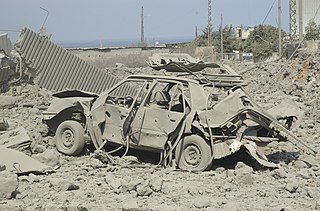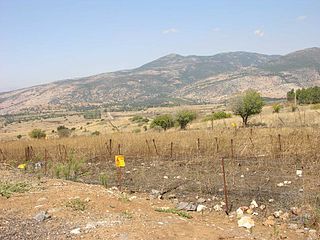
Operation Grapes of Wrath, known in Lebanon as the April Aggression, was a seventeen-day campaign of the Israeli Defense Forces (IDF) against Hezbollah in 1996 which attempted to end the Iran-backed group's rocket attacks on northern Israeli civilian centres by forcing the group north of the Litani River, out of easy range of these civilian centres. Prior to the operation, Hezbollah had launched 151 rockets from Lebanon into Israel, killing two Israeli civilians and seriously wounding 24 other Israeli civilians.
This is a timeline of events related to the 2006 Lebanon War.

The 2006 Qana airstrike was an airstrike carried out by the Israeli Air Force (IAF) on a three-story building in the small community of al-Khuraybah near the South Lebanese village of Qana on July 30, 2006, during the 2006 Lebanon War. The strike killed 28 civilians, 16 of whom were children. Israel halted airstrikes for 48 hours following the attack, amid increasing calls for a ceasefire in the conflict between Israel and Lebanon's Hezbollah guerrillas.
There were many casualties in the 2006 Lebanon War, leading to condemnation of both sides, however the exact distribution of casualties has been disputed. The Lebanese Higher Relief Council (HRC), UNICEF, and various press agencies and news organizations have stated that most of those killed were Lebanese civilians, however the Lebanese government does not differentiate between civilians and combatants in death toll figures. The Israeli government identified 43 Israeli civilians killed by Hezbollah rocket attacks, including four who died of heart attacks during rocket attacks. The Israel Defense Forces (IDF) death toll ranges from 118 to 121, depending on the source and whether or not casualties that occurred after the ceasefire are included. The figures for the Hezbollah fighters killed are the most varying, with Hezbollah claiming 250 of its fighters killed, while Israel claimed to have identified 530 dead Hezbollah fighters. The IDF estimates 600–700 dead Hezbollah fighters. Sources can be conflicting.

International reactions to the 2006 Qana airstrike, which saw the greatest loss of civilian life in the 2006 Israel-Lebanon conflict, twenty eight deaths with thirteen missing, largely involved the condemnation of Israel by many countries around the globe, bringing about a supposed 48 hours cessation of air operations by the Israeli Air Force. Bombings resumed only a few hours after the start of the cessation of air operations.
The 2006 Shiyyah airstrike was an attack by the Israel Air Force (IAF) on the Shiyyah suburb in the Lebanese capital of Beirut on August 7, 2006, during the 2006 Lebanon War. Two missiles fired from an IDF bomber destroyed three apartment buildings in the suburb. Contemporary news accounts stated that the death toll from the airstrikes rose as recovery efforts continued, with 50 corpses recovered at the time of reportage and 61 anticipated.
The 2006 Ghaziyeh airstrikes also referred to as the 2006 Ghaziyeh massacre were two sequential attacks by the Israel Air Force (IAF) on the city of Ghaziyeh in Lebanon on August 7, and August 8, 2006. The attacks took place during the 2006 Lebanon War. In the first attack on August 7, the IAF bombed a building killing 16 people. In the second attack on August 8, the IAF fired five missiles into three buildings killing a total of 8 to 14 civilians and wounding 33. A total of 26 to 30 civilians died in the attacks.
The 2006 Marjayoun convoy was a convoy of approximately 759 vehicles containing Lebanese police, army, civilians, and one Associated Press journalist, which was attacked by the Israeli Air Force (IAF) as it travelled away from the area of Marjayoun on August 11, 2006. Marjayoun is a predominantly Christian town about 8 km (5.0 mi) from the border with Israel.

A number of incidents of attack on civilian and UN convoys have been reported. The Israel Defense Forces has disputed involvement in some cases, and has also alleged that no prior coordination took place before some affected convoys set out. These allegations have in turn been disputed. There have also been reports that fear of aerial attack has prevented drivers from transporting humanitarian aid within Lebanon. One estimate two weeks into the conflict placed the number of Lebanese truck drivers who had died as a result of IDF/IAF air strikes on convoys as "dozens".
This is a timeline of the 2006 Lebanon War during early August.

The 2000–2006 Shebaa Farms conflict was a low-level border conflict between Israel and Hezbollah for control of Shebaa Farms, a disputed territory located on the Golan Heights–Lebanon border. Fighting between the two sides primarily consisted of Hezbollah rocket and mortar attacks on Israel and Israeli artillery barrages and airstrikes on Hezbollah in southern Lebanon. Clashes began a few months after the 2000 Israeli withdrawal from Lebanon, which Hezbollah viewed as incomplete due to the presence of the Israel Defense Forces in Shebaa Farms. The conflict culminated in the 2006 Lebanon War; Israel retains control over the territory.

The History of the Israel Air Force begins in May 1948, shortly after the formation of the State of Israel. Following Israel's declaration of independence on May 14, its pre-state national institutions transformed into the agencies of a state, and on May 26, 1948, the Israeli Air Force was formed. Beginning with a small collection of light aircraft, the force soon transformed into a comprehensive fighting force. It has since participated in several wars and numerous engagements, becoming what has been described as "The mightiest air force in the Middle East".
The Iran–Israel conflict during the Syrian civil war refers to the Iranian–Israeli standoff in and around Syria during the Syrian conflict. With increasing Iranian involvement in Syria from 2011 onwards, the conflict shifted from a proxy war into a direct confrontation by early 2018.
Events in the year 2024 in Lebanon.
This timeline of the Israel–Hezbollah conflict covers the period from 24 November 2023, when the first ceasefire between Israel and Hamas began, until 1 January 2024, one day prior to the assassination of Saleh al-Arouri.
This timeline of the Israel–Hezbollah conflict covers the period from 2 January 2024, with the Assassination of Saleh al-Arouri, until 31 March 2024, one day prior to the Israeli airstrike on the Iranian consulate in Damascus.
This timeline of the Israel–Hezbollah conflict covers the period from 1 April 2024, when Israel struck the Iranian consulate in Damascus, to 26 July 2024, one day before the Majdal Shams attack.
This timeline of the Israel–Hezbollah conflict covers the period from 27 July 2024, when a Hezbollah rocket struck a soccer field in Majdal Shams in the Golan Heights, killing 12 children, to 16 September 2024, one day before the explosion of Hezbollah pagers and walkie talkies.
On 23 September 2024, Israel began a series of airstrikes in Lebanon as part of the ongoing Israel–Hezbollah conflict with an operation it code-named Northern Arrows. Since then, Israel's attacks have killed over 800 people, injured more than 5,000, and displaced hundreds of thousands of Lebanese civilians. The attacks are the deadliest in Lebanon since the end of the Lebanese Civil War, and began five days after Israel performed a deadly pager and walkie-talkie attack on devices intended for Hezbollah members, and three days after Israel performed an airstrike on an apartment complex in Beirut which killed Redwan Force commander Ibrahim Aqil as well as 54 others.






